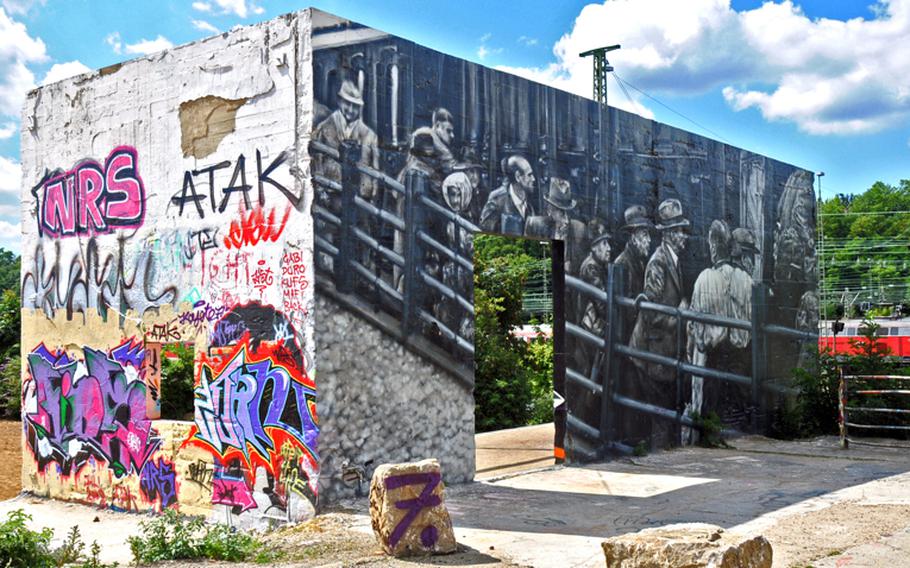
This large mural on the walls of a U-shaped structure has been stripped, cleaned and painted over by its original artist, known as Jorkar 7. It shows the deportation of Jews from Wiesbaden, Germany, in 1944, based on a photograph taken by a city policeman. The stark black-and-white work stands out among the colorful graffiti at the Schlacthof, the city's former slaughterhouse district. The finished work will be part of a park that is still being created. (Peter Jaeger/Stars and Stripes)
Let’s face it, there is more than one way to look at graffiti.
Most of it is quickly and poorly done, a smear on public property, an eyesore to most who see it.
Some, however, is a work of art, a boldly painted mural on a legally designated spot.
While some sprayers end up in jail, others wind up in art galleries.
The latter can be examined around Wiesbaden, often called the Graffiti Capital of Germany by insiders. It got that name after the city closed its slaughterhouse district near the main train station in the 1990s. Soon the empty main building was hosting alternative rock concerts, and young, self-taught artists were using the outside walls as exhibition space for graffiti art, creating a large open-air gallery. It received the blessing of the city — and even financial support — and soon became a cultural addition to the old spa city’s operas, concerts and museums.
While music fans packed the inside of the Schlachthof concert hall, the buildings’ exteriors became a mecca for spray-painting taggers. They used the walls as canvases for their colorful works, and the grounds for their so-called “wall street meetings,” also legalized by the city of Wiesbaden. Every year well-known international graffiti artists gathered in the city for these meetings and to spray their imaginative, wild and creative images onto the large concrete walls of the former slaughterhouses.
Standing out among the colorful creations is a black-and-white scene painted on one side of a large, U-shaped structure. Done in photo realistic style, it shows a group of people entering a train behind a grate. It captures one moment of one of Wiesbaden’s darkest hours, the deportation of its Jewish citizen to the death camps in eastern Europe.
The mural was originally sprayed by a young Wiesbaden artist known as Jorkar 7, using a photograph taken by a policeman in 1944. Found in an archive in Wiesbaden, the photo documents the original historical location of the ramp, exactly where Jorkar created his impressive image.
Recently, the wall was thoroughly cleaned and Jorkar redid the painting. The whole site has been transformed into a memorial for the deported Jews and has been incorporated into a cultural and recreational park that is being completed on the old slaughterhouse grounds. An opening ceremony for the park was held last month.
While the park is helping preserve the mural, it is not all good news for graffiti artists and their fans. Several old building in the area were torn down, and the “wall street meetings” were forced to find a new location, and name, for their annual gatherings.
They did not have to go far.
About eight years ago they began meeting in nearby Mainz-Kastel underneath the big traffic circle at the beginning of the Theodor Heuss bridge, which crosses the Rhine River and connects it with the city of Mainz. The gathering is part of the international “Meeting of Styles,” and this week, from Friday through Sunday, 80 artists from Germany, Poland, Hungary, South America and elsewhere will cover some 32,000 square feet of walls with fresh murals, according to Manuel Gerullis, a Wiesbaden graffiti artist and organizer of the MOS.
The artists — who most years include some Americans — go by names like Three Steps, Stick Up Kids and Urban Code. They work together under a main concept, but each in their own style. Their work is creative and colorful — and often political, criticizing the establishment. While they work, disc jockeys provide music for the spectators who come to join in the fun.
Graffiti art often has a short life, and even complex murals can be sprayed over within days or weeks. However, an unwritten code of honor among artists maintains that the new work has to be better than the one underneath, says Gerullis. That is why some samples last for a long time.’
The images on this page were collected during the past four years at the Sclachthof, under the Theodor Heuss bridge and elsewhere in Mainz-Kastel. They show a variety of styles and the high artistic quality of some of the longer-lasting works.
One newly painted wall shown at top right page illustrates Mainz-Kastel’s Roman past. Twenty artists worked together under the supervision of End of the Line and Pennine Nomads. The huge artwork overlooking a parking lot was designed to stay and permanently brighten up the area, part of what Gerullis proudly calls graffiti’s “colorful revolution.”